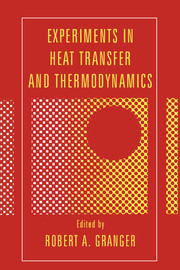Book contents
- Frontmatter
- Contents
- Preface
- Introduction
- Part I Experiments in heat transfer
- I.1 Conduction
- I.2 Convection
- Experiment 7 A forced convection heat-transfer experiment
- Experiment 8 Reynolds analogy for mass transfer
- Experiment 9 Natural-convection melting of a slab of ice
- Experiment 10 Forced-convection heat loss from 3D solids
- Experiment 11 Forced and free convective heat transfer of a laminar flow in a horizontal heated pipe
- Experiment 12 Measurement of convective heat-transfer coefficients on external surfaces
- Experiment 13 Measurement of local heat-transfer coefficient on the ice surface around isothermally cooled cylinders arranged in a line
- Experiment 14 Experiments of unsteady forced convection in ducts with timewise variation of inlet temperature
- Experiment 15 Measurement of heat and mass transfer from a body in air–water mist flow
- Experiment 16 Measurement of transient/steady heat-transfer coefficient with simultaneous photography of flow processes from beneath the heater surface
- I.3 Boiling
- I.4 Mixing, dispersion, and diffusion
- I.5 Radiation
- I.6 Heat pipes and exchangers
- Part II Experiments in thermodynamics
- Appendix 1 Experiments and demonstrations in thermodynamics
- Appendix 2 Experiments and demonstrations in heat transfer
- Appendix 3 Heat-transfer and thermodynamic films
- Index
Experiment 9 - Natural-convection melting of a slab of ice
Published online by Cambridge University Press: 05 June 2012
- Frontmatter
- Contents
- Preface
- Introduction
- Part I Experiments in heat transfer
- I.1 Conduction
- I.2 Convection
- Experiment 7 A forced convection heat-transfer experiment
- Experiment 8 Reynolds analogy for mass transfer
- Experiment 9 Natural-convection melting of a slab of ice
- Experiment 10 Forced-convection heat loss from 3D solids
- Experiment 11 Forced and free convective heat transfer of a laminar flow in a horizontal heated pipe
- Experiment 12 Measurement of convective heat-transfer coefficients on external surfaces
- Experiment 13 Measurement of local heat-transfer coefficient on the ice surface around isothermally cooled cylinders arranged in a line
- Experiment 14 Experiments of unsteady forced convection in ducts with timewise variation of inlet temperature
- Experiment 15 Measurement of heat and mass transfer from a body in air–water mist flow
- Experiment 16 Measurement of transient/steady heat-transfer coefficient with simultaneous photography of flow processes from beneath the heater surface
- I.3 Boiling
- I.4 Mixing, dispersion, and diffusion
- I.5 Radiation
- I.6 Heat pipes and exchangers
- Part II Experiments in thermodynamics
- Appendix 1 Experiments and demonstrations in thermodynamics
- Appendix 2 Experiments and demonstrations in heat transfer
- Appendix 3 Heat-transfer and thermodynamic films
- Index
Summary
Principle
The heat transfer across the air boundary layer that descends along a vertical ice slab causes melting at the surface.
Objective
The effect of heat transfer by boundary-layer natural convection over a vertical wall can be visualized and measured by experimenting with thin slabs of ice suspended vertically in still air. The uneven distribution of heat flux is demonstrated by the uneven thinning of the ice slab. The instantaneous flow rate of meltwater collected under the dripping ice is a measure of the overall heat transfer rate from the ambient to the isothermal surfaces of the slab. An additional objective of this experiment is to show that laboratory apparatuses can be built quite inexpensively, often by using kitchen utensils. This experiment teaches a group of students to critically evaluate each others' data, and to pool all their findings into a comprehensive report that may have engineering significance.
Apparatus
Baking pan
Refrigerator
String
Cardboard box
Sheet-metal tray
Thermometer
Graduated beaker
Clock
The heart of the apparatus is a vertical slab of ice, which is suspended by means of a string in still air. The manufacture of the ice slab and its suspension and the maintenance of a nearly motionless and isothermal ambient are the critical aspects of the apparatus construction.
An inexpensive way of producing ice slabs of one or more sizes is to use a flat-bottom baking pan (or cookie sheet) placed horizontally in the freezer of a household refrigerator.
- Type
- Chapter
- Information
- Experiments in Heat Transfer and Thermodynamics , pp. 54 - 60Publisher: Cambridge University PressPrint publication year: 1994



